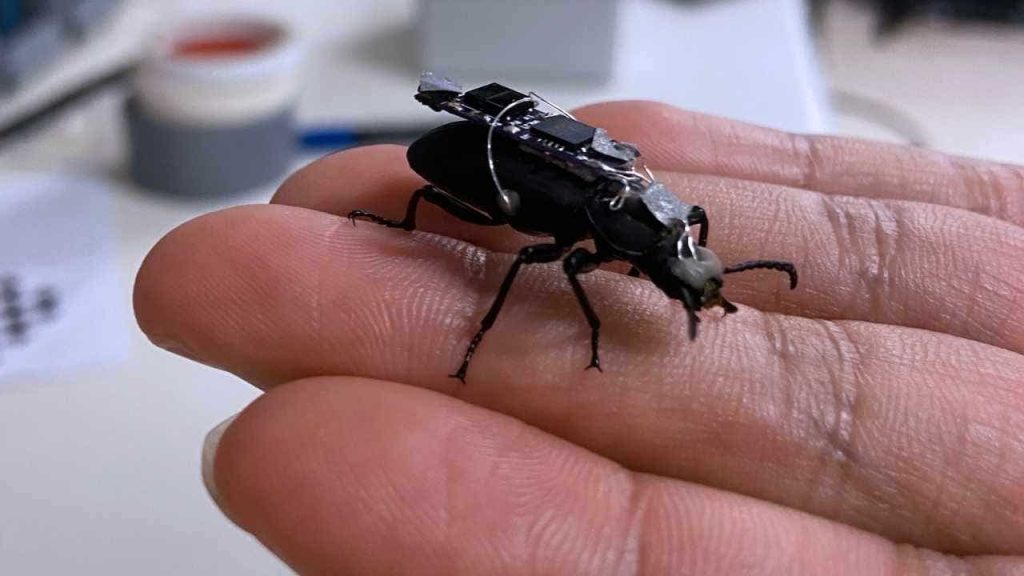body { font-family: Arial, sans-serif; }
Researchers at the University of Queensland have pioneered an innovative approach to emergency rescue operations by developing remote-controlled cyborg beetles. Equipped with small, detachable backpacks, these beetles aim to enhance the speed and effectiveness of locating survivors in disaster scenarios. This breakthrough combines biological agility with technology, offering a promising solution for challenging navigation in hard-to-reach areas during crises.
| Article Subheadings |
|---|
| 1) Understanding the Innovation Behind Cyborg Beetles |
| 2) The Biological Advantages Over Traditional Robots |
| 3) The Ethical Considerations of Cyborg Technology |
| 4) Future Prospects for Cyborg Beetles in Search and Rescue |
| 5) Public Perception and Acceptance of Cyborg Beetles |
Understanding the Innovation Behind Cyborg Beetles
The concept of integrating biological organisms with technology is not merely an imaginative sci-fi premise; it is a present-day reality. Researchers at the University of Queensland have developed cyborg beetles, known scientifically as Zophobas morio, by attaching microchip backpacks that communicate with the beetles. These backpacks send electrical signals that stimulate the insect’s antennae or forewings, enabling real-time control of their movements.
The idea is not just about controlling an insect but harnessing its innate strengths. In various disaster scenarios, such as building collapses or earthquake aftermaths, every second counts. The cyborg beetles could, theoretically, traverse through debris, allowing rescue teams to pinpoint locations of trapped individuals more quickly and efficiently than traditional methods.
The Biological Advantages Over Traditional Robots
Unlike conventional robots, these cyborg beetles bring forth natural advantages that are particularly useful in disaster scenarios. Traditional rescue robots often require bulky motors and complex mechanics, making them less effective in navigating tight, uncertain spaces. The natural agility of the beetles allows them to maneuver effortlessly through narrow gaps and over challenging terrains.
The beetles are uniquely structured to carry almost equal weights to their own body, making them ideal candidates for outfitting with compact sensors. Furthermore, they possess robust footpads and specialized sensory systems that make them adept at crawling through precarious environments without difficulty.
The Ethical Considerations of Cyborg Technology
The emergence of cyborg beetles raises various ethical questions. Is it appropriate to modify living organisms for human benefit, even if the intentions are noble, such as saving lives? Researchers are keenly aware of these concerns and have made efforts to ensure that the technology does not harm the beetles in any substantial way. The backpacks are designed to be lightweight, avoiding major interference with the beetles’ natural behavior and lifespan.
Addressing ethical concerns remains critical for researchers, especially in a field where public perceptions about genetic manipulation and technology’s role in nature are evolving. Transparency and open dialogue about the technology’s applications will be necessary for gaining public trust.
Future Prospects for Cyborg Beetles in Search and Rescue
Looking ahead, researchers are keen on enhancing the functionality of these cyborg beetles. Current plans include integrating advanced technologies, such as miniature cameras and efficient power systems, to boost their utility in rescue missions. The expectation is that these features will allow the beetles to provide real-time visual data from within collapsed structures or hazardous locations, potentially revolutionizing emergency response strategies.
The researchers hope to conduct live simulations to evaluate the system’s effectiveness in real-world situations within the next five years. Success in these tests could mean the adoption of cyborg beetles into urban rescue efforts worldwide, significantly enhancing recovery operations during emergencies.
Public Perception and Acceptance of Cyborg Beetles
As with any emerging technology, especially those involving living creatures, public opinion plays a pivotal role in determining the viability of cyborg beetles for rescue operations. Many may initially react with skepticism or fear, envisioning potential scenarios where technology surpasses its intended purpose or causes unforeseen consequences.
To foster acceptance, authorities and researchers must engage with the community, emphasizing the technology’s life-saving potential. Educational campaigns can help to demystify the capabilities and intentions of cyborg technology, highlighting its positive impacts while addressing ethical worries.
| No. | Key Points |
|---|---|
| 1 | Cyborg beetles can quickly locate survivors in disaster situations due to their agility. |
| 2 | The integration of technology and biology showcases vast potential in emergency response. |
| 3 | Ethical discussions are crucial for advancing cyborg technology responsibly. |
| 4 | Future enhancements involve adding cameras and real-time data transmission capabilities. |
| 5 | Public engagement will be essential for the acceptance of cyborg beetles in rescue operations. |
Summary
The advent of cyborg beetles marks a significant technological breakthrough in emergency response. By combining the natural capabilities of insects with innovative control technologies, researchers are poised to develop a life-saving tool that could change the landscape of search and rescue missions. As the project progresses, ongoing public dialogue and ethical considerations will be vital in determining its acceptance and eventual implementation.
Frequently Asked Questions
Question: What are cyborg beetles?
Cyborg beetles are beetles modified with microchip backpacks that allow researchers to control their movements remotely. This technology aims to assist in search and rescue operations by navigating difficult terrains.
Question: What advantages do cyborg beetles have over traditional robots?
Cyborg beetles possess natural abilities to navigate tight spaces and uneven surfaces, which traditional robots often struggle with. Their lightweight, agile structure allows them to reach areas that may be inaccessible to machines.
Question: What are the future plans for cyborg beetles in rescue operations?
Researchers aim to enhance cyborg beetles by adding miniature cameras and improved power systems. They plan to conduct live tests within the next five years to assess their effectiveness in real-world emergency scenarios.


